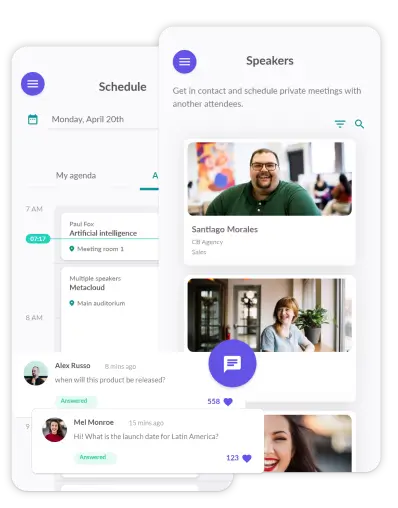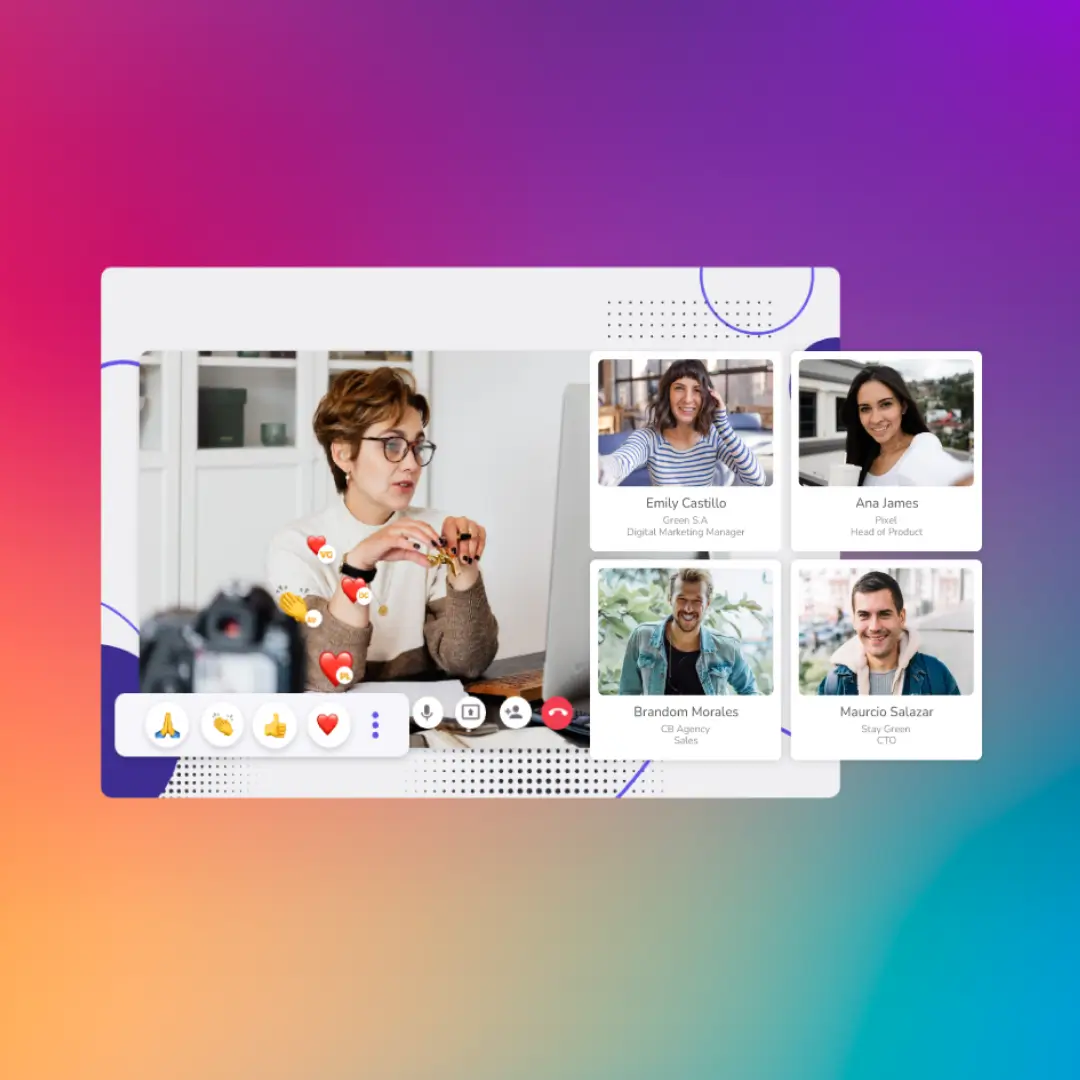No matter how much time, effort, and budget go into planning an event, its ultimate value lies in the results it delivers. Whether it’s a corporate conference, fundraising gala, product launch, or community festival, event organizers need clear metrics to understand whether their event was successful and how to improve future efforts.
Event success isn’t just about how many people attended. It’s about how engaged they were, what outcomes the event generated, and whether it met the organizer’s goals, be they financial, strategic, or experiential. However, almost 40% of event organizers struggle to demonstrate ROI for an event.
This guide will walk you through how to measure event success using both quantitative and qualitative data, with a breakdown of common metrics, tools, and tips to help ensure your next event delivers measurable value.
First: Assess Your Event Purpose and Goals
Before diving into event success metrics, data, and post-event reports, take a step back and ask: What was the purpose of the event? Different types of events serve different functions, so it’s important to focus on KPIs that match your goals, and to ensure all stakeholders are on the same page about those goals from the start. Below are a few common event goals and the specific KPIs that can help you measure success for each.
Brand Awareness
If the main purpose of your event was to raise visibility, attract new audiences, or position your brand as a thought leader, you’ll want to focus on reach and engagement. Relevant KPIs might include:
- Number of event registrations
- Social media impressions and mentions
- Increase in social followers during and after the event
- Growth in email subscribers or newsletter signups
- Media coverage or earned press
- Branded hashtag usage
For example, a company hosting a panel discussion on sustainability might measure brand awareness success by tracking the number of press mentions, new LinkedIn followers, and attendee demographics.
Lead Generation or Customer Acquisition
If the event was focused on capturing qualified leads or driving new customer sign-ups, your KPIs should reflect those conversion-related outcomes. Your KPIs might include:
- Number of new leads captured
- Lead-to-customer conversion rate
- Number of product demos or trial signups
- Cost per lead or cost per acquisition
- CRM activity post-event
As an example, a SaaS company hosting a webinar might track how many registrants signed up for a product trial within 30 days of the event.
Revenue Generation
When revenue is the primary focus, such as with ticketed events, expos with vendor booths, or fundraising galas, you’ll want to zero in on financial performance. To measure this, your KPIs might include:
- Total ticket or registration revenue
- Sponsorship revenue
- On-site or post-event product sales
- Donation totals (for nonprofit events)
- ROI (return on investment) for event spend
A nonprofit hosting an annual gala, for example, might measure success based on donations collected, average gift size, and whether they met their fundraising goal.
Attendee Engagement and Satisfaction
If the goal is to build community or enhance the attendee experience, qualitative and interaction-based metrics will be most valuable. Focus on event success metrics like:
- Post-event survey scores (e.g., Net Promoter Score)
- Session attendance and drop-off rates
- Mobile app engagement (polls, Q&A, chats)
- Time spent at the event or on the platform (for virtual events)
- Repeat attendance for returning events
For example, a professional association hosting its annual conference might evaluate success based on session ratings, speaker feedback, and attendee retention year-over-year.
How to Measure Event Success With ROI
Once your event is complete and the results start rolling in, one of the most important metrics to evaluate is ROI. Event ROI helps you understand whether the resources spent (like money, time, and effort) were worth the results achieved. It’s a critical figure for stakeholders, sponsors, and future event planning decisions.

Event Success Metrics: Quantitative KPIs
When evaluating event performance, quantitative KPIs offer hard data you can track, compare, and use to demonstrate value. By focusing on the right metrics, you can evaluate what worked, identify gaps, and make data-informed decisions for future events. Here are some important quantitative KPIs to help you measure event success.
Event Registrations and Check-Ins
What it is:
- Registrations indicate how many people signed up for your event.
- Check-ins reflect how many of those registrants actually attended.
How to measure it:
Use Eventtia’s event registration platform or ticketing software to track both metrics. It also provides a check-in ratio (attendees ÷ registrants × 100) to help you understand what percentage of your registrants actually attended your event.
Why it matters:
Registrations show interest, while check-ins indicate follow-through and true engagement. A high drop-off rate between the two could point to issues like confusing logistics, poor communication, or scheduling conflicts. Ideally, you’re aiming for a check-in rate of at least 70% for free events and even higher for paid ones. If your event turn-out is low, it might be worth exploring some tips to increase event attendance.
Messages Sent
What it is:
This event success metric tracks the volume of private or group messages exchanged via your event’s mobile app, networking platform, or virtual event platform.
How to measure it:
Eventtia includes an analytics dashboards that tracks in-app messaging, chat interactions, and other networking activity.
Why it matters:
High messaging volume reflects active attendee engagement, networking success, and audience satisfaction. This is especially critical for business conferences, expos, and trade shows where creating meaningful connections is a key goal. It also signals the effectiveness of your app or platform.
Social Engagement
What it is:
Social engagement encompasses likes, shares, comments, branded hashtag use, mentions, and follower growth related to your event.
How to measure it:
Use social media analytics tools (such as Sprout Social, Hootsuite, or native analytics on platforms like LinkedIn and Instagram) to track:
- Number of mentions using your event hashtag
- Engagement rate (likes, comments, shares per post)
- New followers gained during the event window
- Content reach and impressions
Why it matters:
Social media activity reflects both real-time excitement and lasting brand awareness. High engagement can increase your event’s visibility, attract future attendees, and improve sponsor value. It’s also a key metric if one of your event’s goals was brand awareness.
Gross Revenue
What it is:
Gross revenue is the total income generated by the event before deducting any costs. This can include ticket sales, sponsorships, merchandise, food and beverage sales, and donations (for nonprofit events).
How to measure it:
Track all sources of revenue using Eventtia’s financial dashboard, as well as your point-of-sale systems and sponsorship agreements. Be sure to include both pre-event and on-site income.
Why it matters:
Gross revenue is a critical indicator of financial performance. It helps you calculate ROI and determine whether the event met its revenue goals. While net profit is the ultimate financial metric, gross revenue provides insight into top-line success and potential for future scaling.
Returning Attendees
What it is:
This metric tracks how many attendees came back from previous events you’ve hosted.
How to measure it:
Use CRM or Eventtia data to match current attendees with past registrants. Many platforms can automate this comparison or allow you to tag repeat attendees.
Why it matters:
A high number of returning attendees is a strong signal of event quality, value, and brand loyalty. It also lowers marketing costs, as retaining an attendee is typically cheaper than acquiring a new one. If your goal is to build a recurring community or long-term brand presence, this KPI is especially valuable.
Traffic, Leads, SQLs, and New Customers
What it is:
This cluster of KPIs measures the marketing and sales impact of your event:
- Traffic: Website or landing page visits driven by the event.
- Leads: Contacts collected during registration or at the event.
- SQLs (Sales Qualified Leads): Leads that meet your company’s criteria for sales outreach.
- New Customers: People who converted into paying customers post-event.
How to measure it:
- Use Google Analytics or your website analytics platform to track spikes in traffic tied to event campaigns.
- Track leads through Eventtia, contact forms, or lead retrieval tools used at booths.
- Sync leads with your CRM to identify which became SQLs or new customers.
- Use attribution models to link event participation with downstream conversions (e.g., UTM tracking, promo codes, referral links, or post-event email campaigns).
Why it matters:
These KPIs are especially important for B2B and revenue-focused events, where the ultimate goal is to grow your pipeline and convert prospects. They help quantify the event’s impact on your sales funnel, from top-of-funnel awareness (traffic and leads) to bottom-of-funnel revenue (new customers). These metrics also help you justify hosting or sponsoring future events.
Event Metrics Timeline: Pre, During, and Post-Event
Now that we’ve covered the key quantitative KPIs, it’s important to consider when each type of metric, both numerical and experiential should be captured.
Breaking metrics into pre-, during-, and post-event phases ensures you don’t miss critical insights that are only available at certain points in the event lifecycle.
Pre-Event Metrics
Gauge interest and marketing performance before your event begins:
- Registrations & Ticket Sales
- Marketing Reach & Engagement (email, ads, social)
- Promo Code Performance
- Audience Demographics
During-Event Metrics
Track real-time engagement and attendee behavior:
- Check-Ins & Attendance Rates
- Session Attendance & Drop-Offs
- Live Poll Responses
- Networking Activity
- Social Media Activity
Post-Event Metrics
Measure long-term value and satisfaction:
- NPS (Net Promoter Score)
- Lead Conversion Rate
- Sponsor Feedback & Renewal Interest
- Repeat Attendance Rates
- Media Coverage & Brand Lift
Now that we’ve looked at the hard numbers, it’s time to measure the human side of your event, the experiences, feelings, and relationships that can’t always be summed up in a spreadsheet.
Event Success Metrics: Qualitative KPIs
While quantitative KPIs offer clear, numerical insights into your event’s performance, qualitative KPIs provide context and meaning. They help you understand how people felt about the event; what they liked, what they didn’t, and whether the experience delivered value.
These softer metrics may not always be measurable in exact numbers, but they’re just as important for evaluating impact, improving future events, and maintaining relationships with key stakeholders. Here are three essential qualitative KPIs to consider:
Attendee Satisfaction
What it is:
Attendee satisfaction reflects how your guests perceived the event, from the content and logistics to the atmosphere and networking opportunities. It’s a direct measure of how well the event met (or exceeded) expectations.
How to measure it:
- Post-event surveys sent via email or your event app (with Likert-scale questions, open text boxes, and overall satisfaction ratings)
- In-app feedback tools for live or virtual events
- On-site interviews or feedback stations
- Social listening to assess sentiment in tweets, posts, or online reviews
Why it matters:
High attendee satisfaction leads to repeat attendance, positive word-of-mouth, and stronger community engagement. It’s also a key driver of ROI for brand-building events and a great way to identify areas for improvement.
Uncovering pain points (like bad food, unclear signage, or low-value sessions) can help fine-tune your next event. To learn more, check out our guide on how to create event survey questions.
Sponsor Satisfaction
What it is:
Sponsor satisfaction measures how well your event delivered value to your sponsors or partners, whether that’s through brand visibility, lead generation, thought leadership opportunities, or meaningful engagement with attendees.
How to measure it:
- Sponsor feedback surveys with questions about ROI, event organization, and overall satisfaction
- Follow-up interviews or debrief meetings
- Lead reports provided post-event (e.g., booth scans, attendee lists, engagement stats)
- Social/media metrics showing brand exposure or mentions
Why it matters:
Happy sponsors are far more likely to renew partnerships, increase their sponsorship level next year, or recommend your event to others. Since sponsors often represent a major source of event revenue, maintaining their satisfaction is key to long-term sustainability and success.
Media Coverage and Promotion
What it is:
Media coverage reflects the extent and tone of external promotion your event received, from press coverage to blog mentions, podcasts, and influencer shoutouts.
How to measure it:
- Media monitoring tools like Meltwater or Google Alerts
- Clipping reports from PR agencies or internal communications teams
- Tracking influencer posts or partner content
- Sentiment analysis on earned coverage
- Comparing media value to what similar coverage would cost as paid advertising (Ad Value Equivalency or AVE)
Why it matters:
Positive media coverage enhances your event’s reputation, increases brand awareness, and provides social proof for future sponsors and attendees. It also shows that your event resonated beyond the walls (or screens) where it took place, which is an important factor for thought leadership, product launches, or public-facing events.
Long-Term Impact Metrics
Most event reports are finalized within days or weeks after the event, but some of the most valuable results only emerge months later. Tracking long-term impact metrics helps you understand the sustained effects of your event, whether on brand perception, sales growth, community engagement, or customer loyalty.
Examples of Long-Term Metrics
- Brand Lift Studies – Comparing pre- and post-event awareness, perception, or favorability through surveys or market research.
- Ongoing Lead Nurturing Performance – Measuring whether leads acquired at the event progress through your sales funnel over 3–12 months.
- Customer Retention & Lifetime Value (LTV) – Evaluating whether customers sourced from events remain engaged and profitable long-term.
- Partnership Growth – Tracking whether relationships initiated at the event evolve into formal collaborations, joint ventures, or sponsorship renewals.
- Community Development – Monitoring membership growth, repeat participation in forums or meetups, and ongoing content engagement sparked by the event.
- Advocacy & Referrals – Measuring how many attendees go on to refer others, speak positively online, or become ambassadors for your brand.
Out of all the qualitative KPIs you can track, one is especially popular for its ease and usefulness: the Net Promoter Score (NPS). It’s a simple, standard question that helps you quickly see how happy your attendees were and whether they’d recommend your event to others. That’s why so many event organizers and stakeholders rely on it.
What Is the Net Promoter Score and Why Does It Matter?
NPS is a single-question metric designed to measure customer or attendee loyalty. The question typically goes like this:
“On a scale of 0 to 10, how likely are you to recommend this event to a friend or colleague?”
Based on their responses, participants are grouped into three categories:
- Promoters (9–10): Enthusiastic supporters who are likely to recommend your event and return in the future.
- Passives (7–8): Satisfied, but not enthusiastic enough to promote the event.
- Detractors (0–6): Unhappy attendees who may discourage others from attending.
How Is Net Promoter Score Calculated?
To calculate your Net Promoter Score:
- Survey attendees with the standard NPS question.
- Categorize each response into one of the three groups.
Use the formula:
NPS = % of Promoters – % of Detractors
You’ll get a score between -100 and +100.
Example Calculation
Let’s say you surveyed 100 attendees:
- 60 gave a 9 or 10 → 60% Promoters
- 25 gave a 7 or 8 → 25% Passives
- 15 gave 0–6 → 15% Detractors
NPS = 60% – 15% = +45
A score above 0 is considered good, above 50 is excellent, and above 70 is world-class.
Why Is Net Promoter Score Important?
Your Net Promoter Score matters because it’s a quick and powerful way to establish whether or not your event left a lasting, positive impression. It’s simple, standardized, and measures loyalty and advocacy, not just satisfaction. It also helps you predict future behavior like re-attendance, referrals, and positive word-of-mouth.
Measure Event Success With Eventtia
From registrations and revenue to attendee satisfaction and long-term brand value, each event success metric tells part of the story. By combining quantitative KPIs like attendance, leads, and ROI with qualitative insights like NPS scores, sponsor feedback, and media sentiment, you gain a full-picture view of how your event performed, and how to make the next one even better.
With Eventtia’s powerful event management platform, you don’t have to piece together these insights manually. Eventtia offers built-in tools for tracking KPIs, gathering feedback, analyzing ROI, and optimizing every stage of your event. Whether you’re planning a conference, tradeshow, or networking event, Eventtia gives you the data and clarity to measure what matters, so your events can keep growing in impact, reach, and success.
Ready to make your events more measurable and meaningful? Schedule an Eventtia demo to learn how.
Discover how Eventtia helps world-leading brands digitize and scale their events
Learn more
Share










